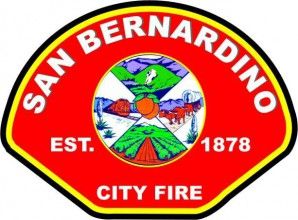Bankruptcy could cut San Bernardino fire pensions
by Wayne Lusvardi | September 15, 2014 4:41 pm
 It was a hot 102 degrees last Thursday in San Bernardino — perfect weather for a city bankruptcy “cramdown.” Federal Bankruptcy Court Judge Meredith Jury ruled the city, as Reuters reported[1], “may impose cuts to its firefighters’ overtime and pension benefits in a bid to reach a bankruptcy exit plan.”
It was a hot 102 degrees last Thursday in San Bernardino — perfect weather for a city bankruptcy “cramdown.” Federal Bankruptcy Court Judge Meredith Jury ruled the city, as Reuters reported[1], “may impose cuts to its firefighters’ overtime and pension benefits in a bid to reach a bankruptcy exit plan.”
In bankruptcy law parlance, according to Investopedia[2]:
“Cramdown allows the bankruptcy courts to modify loan terms subject to certain conditions in an attempt to have all parties come out better than they would have without such modifications. The conditions are mainly that the new terms are fair and equitable to all parties involved.”
The city wants keep vacant positions for firefighters who don’t show up for work[3]. That would cut $4 million in overtime costs. And firefighters would have to pick up the former city contribution[4] to their pensions, which amounts to 14 percent of their net pay.
Jury said the city was persuasive in proving the current pensions and benefits contributed to the city’s bad finances. She now is allowing the city to reject the firefighters’ collective bargaining agreement.
In the bankruptcies of private businesses, federal bankruptcy courts have near-total discretion in disposing of assets and liabilities. But the San Bernardino and Detroit bankruptcies are testing whether judges have similar powers in municipal bankruptcies, in particular involving union contracts and pension obligations.
San Bernardino’s city charter[5] expressly forbids imposing pay cuts on police or firefighters’ salaries, so the cuts have to be made to overtime and pension benefits. The city is pursuing an amendment to its charter in a ballot initiative in November that would allow cuts in police and firefighters salaries as well.
The firefighters’ union[6] wants to appeal the judge’s decision based on allegations the city didn’t follow state law in its negotiations. Judge Jury[7] said their claim was mostly not legitimate.
Lucrative
The bankruptcy proceedings have brought forth the reason the city went bust.
Annual pay[8] for the top 40 San Bernardino firefighters averages $190,000. And it averages $166,000 even for the bottom 40 firefighters.
If the court-ordered changes are enacted, those amounts would be reduced, respectively, to about $163,400 and $142,760. The latter number still would be 3.6 times the city’s median income of $39,097[9]. Moreover, San Bernardino remains one of the least expensive places to live in California, with the median price of a home $166,100, less than half the state price of $383,900.[10]
San Bernardino filed for bankruptcy under Chapter 9 of the Federal Bankruptcy Code in August 2012[11]. At that time the city was running a $45 million annual operating budget deficit. As of January 7, 2013, the City General Fund had an $18,730,274 operating deficit[12].
San Bernardino reached an agreement with the California Public Employee’s Retirement System in June[13] this year that cannot be disclosed due to a judicial gag order. The city already has started making back payments to CalPERS for pension contributions. Another undisclosed deal with the city’s police union was reached in August[14].
Economic problems
The immediate cause[15] of the bankruptcy was the city’s establishment of pension benefits equivalent to wealthier cities its own size, rather than pegged to its economic and tax base. Although the city’s economy finally has begun recovering from the Great Recession, it enjoys nothing near the productivity of such wealthy California coastal areas as Silicon Valley.
Even before the Great Recession, the city was hit with the closure of Norton Air Base[16]. The city lost its economic base and has become a magnet for lower-end housing.
The city’s unemployment rate was 12.2 percent[17] as of July 2014. And 17.6 percent[18] of the population was below the poverty level in 2012.
Building permits were down from 537 in 2005 to 23 in 2012. Burglaries are running at an all-time high of 1,306 per 100,000 of population as of 2012.
The city lost 32,937 in population from 2000[19] to 2012[20]. San Bernardino[21] is the poorest city of its size in California and the second poorest in the United States after Detroit, which also gave its employees lavish pay and benefits that could not be sustained.
Selling water
Strangely, the bankruptcy has not advanced consideration of one source of income for the city: groundwater. It is especially valuable during this time of drought.
The city is unique in arid Southern California because it has more groundwater than it needs. It has so much groundwater that 1.5 million acre-feet are potentially extractable[22].
Plans have been in the works for decades to sell some of its excess groundwater[23] to other water agencies, but this has never happened due the quality of the groundwater[24], local problems and California’s bureaucratic water transfer process.
The huge regional Inland Feeder[25] water pipeline is about 10 miles east, but the city has never capitalized on its proximity as a potential economic resource.
- Reuters reported: http://www.reuters.com/article/2014/09/11/us-usa-municipals-bernardino-idUSKBN0H62N320140911
- Investopedia: http://www.investopedia.com/terms/c/cramdown.asp
- who don’t show up for work: http://www.sbsun.com/government-and-politics/20140911/san-bernardino-wins-2-victories-against-firefighters-union-in-bankruptcy-court
- pick up the former city contribution: http://www.sbsun.com/government-and-politics/20140911/san-bernardino-wins-2-victories-against-firefighters-union-in-bankruptcy-court
- city charter: http://www.reuters.com/article/2014/09/11/us-usa-municipals-bernardino-idUSKBN0H62N320140911
- firefighters’ union: http://www.sbsun.com/government-and-politics/20140911/san-bernardino-wins-2-victories-against-firefighters-union-in-bankruptcy-court
- Judge Jury: http://www.sbsun.com/government-and-politics/20140911/san-bernardino-wins-2-victories-against-firefighters-union-in-bankruptcy-court
- Annual pay: http://www.reuters.com/article/2014/09/11/us-usa-municipals-bernardino-idUSKBN0H62N320140911
- median income of $39,097: http://quickfacts.census.gov/qfd/states/06/0665000.html
- state price of $383,900.: http://quickfacts.census.gov/qfd/states/06/0665000.html
- August 2012: http://www.cacb.uscourts.gov/case-of-interest/city-san-bernardino
- 18,730,274 operating deficit: http://www.sbcity.org/civicax/filebank/blobdload.aspx?blobid=14665
- June: http://www.reuters.com/article/2014/06/18/usa-municipality-sanbernardino-idUSL2N0OZ26Q20140618
- August: http://www.pe.com/common/templates/post-article.php?post_url=/news/2014/08/14/san-bernardino-bankrupt-city-police-union-reach-agreement/
- cause: http://www.huffingtonpost.com/2012/07/15/san-bernardino-bankruptcy-political-feuds-denial_n_1674936.html
- Norton Air Base: http://en.wikipedia.org/wiki/Norton_Air_Force_Base
- 12.2 percent: http://www.labormarketinfo.edd.ca.gov/CES/Labor_Force_Unemployment_Data_for_Cities_and_Census_Areas.html
- 17.6 percent: http://quickfacts.census.gov/qfd/states/06/06071.html
- 2000: http://factfinder2.census.gov/faces/tableservices/jsf/pages/productview.xhtml?src=bkmk
- 2012: http://factfinder2.census.gov/faces/tableservices/jsf/pages/productview.xhtml?src=bkmk
- San Bernardino: http://en.wikipedia.org/wiki/San_Bernardino,_California
- 1.5 million acre-feet are potentially extractable: http://www.sbcity.org/civicax/filebank/blobdload.aspx?blobid=8042
- sell some of its excess groundwater: http://en.wikipedia.org/wiki/San_Bernardino,_California
- quality of the groundwater: http://www.sbcity.org/civicax/filebank/blobdload.aspx?blobid=8042
- Inland Feeder: http://www.tunneltalk.com/images/ArrowheadSuccess/Arrowhead-replacement-map.jpg
Source URL: https://calwatchdog.com/2014/09/15/bankruptcy-could-cut-san-bernardino-fire-pensions/